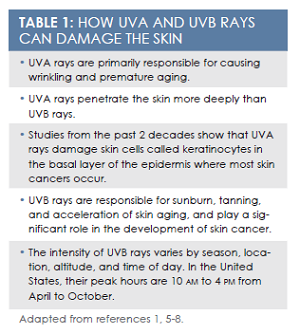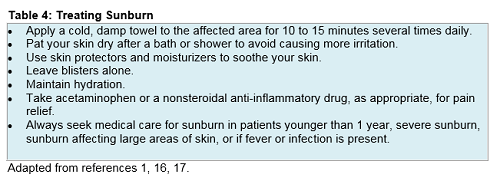Sun Damage: Protecting Your Skin and Eyes
Despite constant reminders, many individuals still underestimate the importance of taking care of their skin.
Despite constant reminders, many individuals still underestimate the importance of taking care of their skin.
Many individuals attempt to be proactive about their overall health, but they often underestimate the importance of taking care of their skin—that is, until a dermatologic issue occurs. If you are like most people, you are always looking for better ways to take care of your skin and eyes and protect them from sun damage. Although sunburn is the most common dermatologic issue caused by excessive exposure to ultraviolet radiation (UVR), premature aging, cataracts, and wrinkles (also known as photoaging) can also result.1Moreover, studies dating back to the 1950s show a strong correlation between chronic, excessive, and unprotected sun exposure and carcinoma of the skin.1
Due to the number of skin cancers diagnosed each year, it is important to understand the importance of daily sun protection and avoid excessive exposure to UVR to decrease the incidence of skin cancer, premature skin aging, and other long-term dermatologic issues.1According to the Skin Cancer Foundation, skin cancer is the most common form of cancer in the United States: more than 3.5 million cases are diagnosed every year and in 2012 alone, an estimated 76,250 individuals were diagnosed with malignant melanoma.1,2The foundation also reports that almost 90% of nonmelanoma skin cancers are associated with excessive exposure to UVR and up to 90% of the visible dermatologic changes commonly attributed to aging are caused by the sun.1,2Moreover, the foundation reports that 42% of the population gets an episode of sunburn at least once a year and that an individual’s risk of developing skin cancer may double if 5 or more episodes of sunburn are experienced at any age.1-3Having 1 or 2 cases of blistering sunburn during childhood may even double an individual’s chance of developing melanoma later in life.3,4
The good news is that if detected early, melanoma can be treated and many cases of nonmelanoma skin cancers can be cured.1For additional information on the 2 types of UV rays, UVA and UVB, and how they can damage the skin, seeTable 1.

Although all types of skin complexions have the potential to burn or develop other UVR-induced issues due to excessive sun exposure, certain factors may increase your risk of developing dermatological issues due to sun damage. Examples include1,9:
â—— Having fair skin
â—— Having an autoimmune disease
â—— Using immunosuppressive drugs
â—— Family history of melanoma
â—— Previous skin growth caused by UVR exposure
â—— Individuals with a history of 1 or more serious or blistering sunburns
â—— Infants and children, since their skin is more sensitive than adult skin
â—— Individuals taking certain pharmacologic agents associated with photosensitivity reactions
â—— Having blonde or red hair
â—— Individuals who use tanning beds or sun lamps
â—— Being exposed to the sun during peak hours (10 am to 4 pm) without using UV protection
How Sunscreen Products Work
One of your best defenses against sun damage is the routine use of topical sunscreens when outdoors. Sunscreens absorb or reflect UVA and UVB rays. Their routine use is crucial in protecting your skin from both the short- and long-term damaging effects of sun exposure, since they can decrease incidences of sunburn, premature skin aging, photodermatoses, and skin cancer.1Many studies have demonstrated that when applied correctly, sunscreen can block most of the sun’s harmful UVR and effectively protect your skin.1
Finding the Best Sunscreen
If you need assistance in selecting the best sunscreen product to suit your individual needs, you should always consult your health care professional. Sunscreen products are available in various forms (lotions, creams, and sprays) and sun protection factor (SPF) ranges, and can be water-resistant, as well. Many cosmetics, lip balms, and facial moisturizers also contain sunscreen. It is important to note that the higher the SPF, the more effective the product is at preventing sunburn; however, an SPF higher than 30 may not afford extra protection. Topical sunscreen products can be divided into 2 categories: chemical and physical. SeeTable 2for additional information on both.1,10-12

When selecting a sunscreen, you may consider several factors to find the product that best suits your needs, including cost, skin type and complexion, reasons for use, ease of use, formulation, SPF level, history of sunburn, and medication history (since some pharmacologic agents may be associated with photosensitivity reactions).1,13,14Many of these products— such as broad-spectrum sunscreens, lip balms, cosmetics, and moisturizers— contain a combination of ingredients. The Environmental Protection Agency recommends the use of a broadspectrum sunscreen with a minimum SPF of 30 even on cloudy days.1,12The use of sun protective clothing and sunglasses when possible is also recommended. Sunglasses should block 99% to 100% of both UVA and UVB rays and the frame should be large enough to shield your eyes, eyelids, and surrounding areas.
Sunscreens should be applied liberally to all exposed areas at least 15 to 30 minutes before sun exposure and as often as the product label recommends, or at least every 2 hours.1,11-13In general, an estimated one-half teaspoon should be applied thoroughly to each exposed area to obtain adequate coverage and protection, and sunscreen should be reapplied especially after swimming, towel drying, or excessive sweating.1,11-13If you work outdoors, it is recommended that sunscreen should be reapplied often throughout the day.1,11-13
Conclusion
You should always use a sunscreen when outdoors, especially for extended periods of time. Despite constant reminders about avoiding overexposure to the sun, however, many individuals will still experience sunburn because they do not always use sunscreen when outdoors—especially during the summer—or they apply sunscreen incorrectly. It is important to remember that there are many ways to protect your skin against sun damage as well as to prevent and treat sunburn (Tables 3-5). You should remember that sun protection is equally important during the winter since snow reflects up to 80% of the sun’s rays, which can cause sunburn and damage to exposed skin. Because some medications such as tetracyclines, antidepressants, antihistamines, estrogens, sulfonamides, and nonsteroidal anti-inflammatory drugs can increase your risk of photosensitivity, it is important to always ask your health care professional if you are taking any medications that may cause photosensitivity.



Ms. Terrie is a clinical pharmacy writer based in Haymarket, Virginia.
References
1) Crosby K. Prevention of sun-induced skin disorders. In: Krinsky D, Ferreri S, et al, eds.Handbook of Nonprescription Drugs. 18th ed. Washington, DC: American Pharmacists Association; 2015.
2) Skin cancer facts. Skin Cancer Foundation website. www.skincancer.org/Skin-Cancer-Facts/. Updated February 9, 2015. Accessed February 20, 2015.
3) Facts about sunburn and skin cancer. Skin Cancer Foundation website. www.skincancer.org/prevention/sunburn/facts-about-sunburn-and-skin-cancer. Accessed February 20, 2015.
4) SunWise program summary. US Environmental Protection Agency website. www2.epa.gov/sunwise. Accessed February 20, 2015.
5) Understanding UVA and UVB. Skin Cancer Foundation website. www.skincancer.org/prevention/uva-and-uvb/understanding-uva-and-uvb. Accessed February 20, 2015.
6) UV radiation. US Environmental Protection Agency website www.epa.gov/sunwise/doc/uvradiation.html. Updated July 6, 2015. Accessed February 20, 2015.
7) UV radiation. World Health Organization website. www.who.int/uv/faq/whatisuv/en/index2.html. Accessed February 20, 2015.
8) Shining light on ultraviolet radiation. Skin Cancer Foundation website. www.skincancer.org/prevention/uva-and-uvb/shining-light-on-ultraviolet-radiation. Accessed February 20, 2015.
9) Sunburn: risk factors. Mayo Clinic website. www.mayoclinic.org/diseases-conditions/sunburn/basics/risk-factors/con-20031065. Updated May 1, 2014. Accessed February 20, 2015.
10) Saini R, Szemplinski A. How to choose the right sunscreen for your type of skin. Skin Cancer Foundation website. www.skincancer.org/prevention/sun-protection/sunscreen/choosing. Accessed February 20, 2015.
11) Facts about sunscreens. American Melanoma Association website. www.melanomafoundation.org/prevention/facts.htm.
12) Sunscreen: the burning facts. US Environmental Protection Agency website. www.epa.gov/sunwise/doc/sunscreen.pdf. Accessed February 20, 2015.
13) Sunscreen FAQs. American Academy of Dermatology website. www.aad.org/media-resources/stats-and-facts/prevention-and-care/sunscreens. Accessed February 20, 2015.
14) Sunscreen: how to select, apply, and use it correctly. www.cdc.gov/MMWR/preview/mmwrhtml/rr5104a3.htm. Updated April 11, 2002. Accessed February 20, 2015.
15) Prevention guidelines. Skin Cancer Foundation website. www.skincancer.org/prevention/scf-tips.html. Accessed February 20, 2015.
16) Treating sunburn. American Academy of Dermatology website. www.aad.org/dermatology-a-to-z/for-kids/about-skin/skin-cancer/treating-sunburn. Accessed February 20, 2015.
17) Five ways to treat a sunburn. Skin Cancer Foundation website. www.skincancer.org/prevention/sunburn/five-ways-to-treat-a-sunburn. Accessed February 20, 2015.

